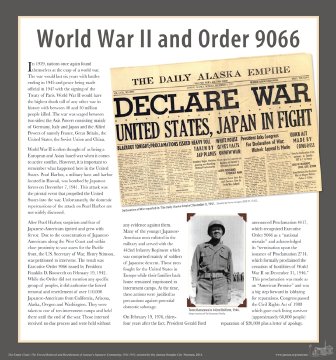|
Description
|
| World War II and Order 9066 In 1939, nations once again found themselves at the cusp of a world war. The war would last six years with battles ending in 1945 and peace being made official in 1947 with the signing of the Treaty of Paris. World War II would have the highest death toll of any other war in history with between 40 and 50 million people killed. The war was waged between two sides: the Axis Powers consisting mainly of Germany, Italy and Japan and the Allied Powers of namely France, Great Britain, the United States, the Soviet Union and China. World War II is often thought of as being a European and Asian based war when it comes to active conflict. However, it is important to remember what happened here in the United States. Pearl Harbor, a military base and harbor located in Hawaii, was bombed by Japanese forces on December 7, 1941. This attack was the pivotal event that propelled the United States into the war. Unfortunately, the domestic repercussions of the attack on Pearl Harbor are not widely discussed. After Pearl Harbor, suspicion and fear of Japanese-Americans ignited and grew with fervor. Due to the concentration of Japanese-Americans along the West Coast and within close proximity to war assets for the Pacific front, the U.S. Secretary of War, Henry Stimson, was petitioned to intervene. The result was Executive Order 9066 issued by President Franklin D. Roosevelt on February 19, 1942. While the Order did not mention any specific group of peoples, it did authorize the forced removal and resettlement of over 110,000 Japanese-Americans from California, Arizona, Alaska, Oregon and Washington. They were taken to one of ten internment camps and held there until the end of the war. Those interned received no due process and were held without any evidence against them. Many of the younger Japanese-American men enlisted in the military and served with the 442nd Infantry Regiment which was comprised mainly of soldiers of Japanese descent. Those men fought for the United States in Europe while their families back home remained imprisoned in internment camps. At the time, these actions were justified as precautions against potential domestic sabotage. On February 19, 1976, thirty-four years after the fact, President Gerald Ford announced Proclamation 4417, which recognized Executive Order 9066 as a "national mistake" and acknowledged its "termination upon the issuance of Proclamation 2714, which formally proclaimed the cessation of hostilities of World War II on December 31, 1946." This proclamation was made as an "American Promise" and was a big step forward in lobbying for reparations. Congress passed the Civil Rights Act of 1988 which gave each living survivor (approximately 60,000 people) reparation of $20,000 plus a letter of apology. Image Captions: Tooru Kanazawa in 442nd Uniform, 1944. Image courtesy of the Kanazawa Family. Declaration of War reported in "The Daily Alaska Empire", December 8, 1941. Donated by Verna Carrigan, JDCM 91.17.052. |
WWII and Order 9066 History Panel
-The Empty Chair: The Forced Removal and Relocation of Juneau's Japanese, 1941-1951
-Permission to use this image may be obtained by contacting museum staff.

All images are the property of the Juneau-Douglas City Museum. No image may be copied, downloaded or reproduced without the express permission of the Juneau-Douglas City Museum.

All images are the property of the Juneau-Douglas City Museum. No image may be copied, downloaded or reproduced without the express permission of the Juneau-Douglas City Museum.